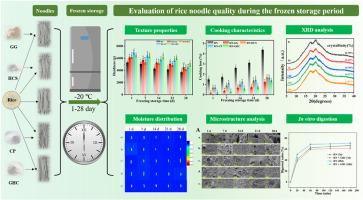添加剂对米粉冷冻贮藏品质的影响:瓜尔胶、羟丙基玉米淀粉、复合磷酸盐及其复合混合物
IF 11
1区 农林科学
Q1 CHEMISTRY, APPLIED
引用次数: 0
摘要
本试验旨在研究瓜尔胶(GG)、羟丙基玉米淀粉(HCS)、复合磷酸盐(CP)及其复合添加剂(GHC)对米粉冷冻贮藏过程中整体品质的影响。28 d后,对照RN质量明显恶化,破损率从24.1%上升到38.5%,硬度从5307.4 g下降到3684.8 g。相比之下,添加单一添加剂的样品表现出适度的改善:RN-GG的破损率为25.0%,RN-HCS为32.6%,RN-CP为28.7%,硬度值分别达到4530.8 g, 4229.9 g和4481.5 g。值得注意的是,GHC表现出优异的性能,保持了21.1%的断裂率和4912.8 g的硬度。低场核磁共振分析显示,与单一添加剂RN相比,RN- ghc中的A21值明显更高,表明凝胶结构的持水能力增强。扫描电镜观察表明,RN-GHC凝胶网络更加连续紧凑,有助于抑制冰晶生长和物理损伤。XRD和拉曼光谱证实了添加剂能有效抑制淀粉的降解。贮藏期后,抗性淀粉含量比对照高22.12%。这是由于GHC保持了一个更连续和致密的凝胶网络,其完整的结构在物理上限制了酶的渗透和结合,从而增加了抗性淀粉的比例。这些发现突出了复合添加剂在提高冷冻淀粉类食品的质量和延长保质期方面的潜力。本文章由计算机程序翻译,如有差异,请以英文原文为准。

The effects of additives on the frozen storage quality of rice noodles: Guar gum, hydroxypropyl corn starch, composite phosphate, and their composite mixture
This study aimed to investigate the effects of guar gum (GG), hydroxypropyl corn starch (HCS), composite phosphate (CP), and their composite additive (GHC) on the overall quality of rice noodles (RN) during frozen storage. After 28 days, the control RN showed marked quality deterioration, with the breakage rate increasing from 24.1 % to 38.5 % and hardness decreasing from 5307.4 g to 3684.8 g. In contrast, samples with single additives exhibited moderate improvements: the breakage rate were 25.0 % for RN-GG, 32.6 % for RN-HCS, and 28.7 % for RN-CP, while hardness values reached 4530.8 g, 4229.9 g, and 4481.5 g, respectively. Notably, the GHC demonstrated superior performance, maintaining the breakage rate at 21.1 % and hardness at 4912.8 g. Low-field NMR analysis revealed a significantly higher A21 value in RN-GHC compared to the single-additive RN, indicating enhanced water-holding capacity of the gel structure. SEM observations showed a more continuous and compact gel network of RN-GHC, which helped inhibit ice crystal growth and physical damage. XRD and Raman spectroscopy confirmed that the additives effectively suppressed starch retrogradation. After the storage period, the resistant starch content in RN-GHC was 22.12 % higher than that in control RN. This is attributed to GHC maintaining a more continuous and dense gel network, whose intact structure physically restricts enzyme permeation and binding, thereby increasing the resistant starch fraction. These findings highlight the potential of composite additives for enhancing the quality and extending the shelf life of frozen starch-based foods.
求助全文
通过发布文献求助,成功后即可免费获取论文全文。
去求助
来源期刊

Food Hydrocolloids
工程技术-食品科技
CiteScore
19.90
自引率
14.00%
发文量
871
审稿时长
37 days
期刊介绍:
Food Hydrocolloids publishes original and innovative research focused on the characterization, functional properties, and applications of hydrocolloid materials used in food products. These hydrocolloids, defined as polysaccharides and proteins of commercial importance, are added to control aspects such as texture, stability, rheology, and sensory properties. The research's primary emphasis should be on the hydrocolloids themselves, with thorough descriptions of their source, nature, and physicochemical characteristics. Manuscripts are expected to clearly outline specific aims and objectives, include a fundamental discussion of research findings at the molecular level, and address the significance of the results. Studies on hydrocolloids in complex formulations should concentrate on their overall properties and mechanisms of action, while simple formulation development studies may not be considered for publication.
The main areas of interest are:
-Chemical and physicochemical characterisation
Thermal properties including glass transitions and conformational changes-
Rheological properties including viscosity, viscoelastic properties and gelation behaviour-
The influence on organoleptic properties-
Interfacial properties including stabilisation of dispersions, emulsions and foams-
Film forming properties with application to edible films and active packaging-
Encapsulation and controlled release of active compounds-
The influence on health including their role as dietary fibre-
Manipulation of hydrocolloid structure and functionality through chemical, biochemical and physical processes-
New hydrocolloids and hydrocolloid sources of commercial potential.
The Journal also publishes Review articles that provide an overview of the latest developments in topics of specific interest to researchers in this field of activity.
 求助内容:
求助内容: 应助结果提醒方式:
应助结果提醒方式:


